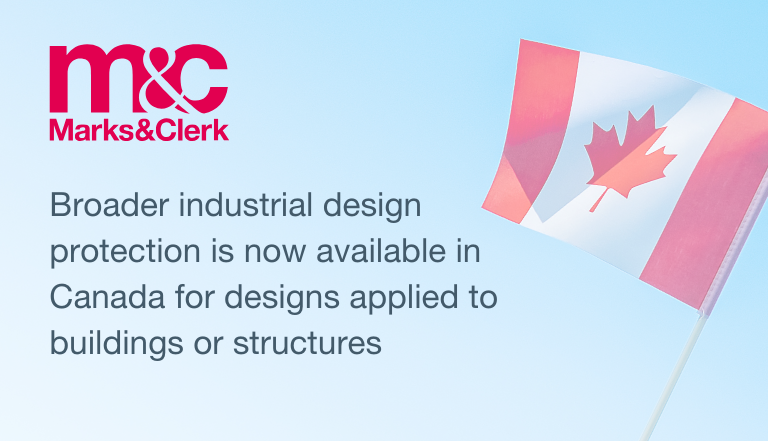On June 14, 2024, the Canadian Intellectual Property Office revised its examination practice to indicate that, with immediate effect, broader industrial design protection may be available in Canada for designs applied to buildings or structures.
Copyright protection has been available in Canada for architectural works in the nature of a building or structure, or any model of a building or structure (see, for example, our article here). To date, however, the Office had taken the position that industrial designs applied to buildings or structures constructed on site were not registrable as they could not be delivered to a purchaser and, therefore, were not considered to be “finished articles” to which a design could be applied. Accordingly, until now, the Office limited registration to designs applied to buildings or structures capable of being preformed, portable and delivered separately to purchasers as finished articles, or in sections to be put together by a simple operation such as bolting. The Office has changed its position.
Designs applied to buildings or structures, including those constructed on site, are now considered to be “finished articles” to which designs may be applied and may now be protected as industrial designs, in addition to benefiting from possible copyright protection.
In contrast with copyright, which does not need to be registered to exist (protection may exist upon creation and registration provides certain presumptions that can ease burdens when enforcing copyright), an industrial design must be applied for and registered for protection to exist.
To be protected, designs applied to buildings or structures must be novel. To be novel, a design must differ substantially from designs previously disclosed to the public in Canada or elsewhere. Novelty is assessed with reference to the features of the design and comparing the design to relevant prior art, taking into consideration any priority date of the design and grace period. While a design must be novel, there is a one-year grace period for designs that have been made available to the public, in Canada or elsewhere, by the applicant (or predecessor in title or person who obtained knowledge of the design from them). An application (or priority application) must be filed within one year of the first public disclosure by the applicant. Not all jurisdictions allow for a grace period, so filing an application before a possible public disclosure is recommended.
The Office indicated that applications for registration of a design applied to a building or structure will be examined as any other application and are not subject to any particular requirement due to the nature of the finished article.
Designs are used to protect the appearance of finished articles. A “design” refers to “features of shape, configuration, pattern or ornament and any combination of those features that, in a finished article, appeal to and are judged solely by the eye”. A design may comprise any combination of shape, configuration, pattern or ornament. Features of “shape” and “configuration” refer to the finished article’s 3D structure. “Shape” refers to the “external form” or “outline” of an article. “Configuration” refers to the arrangement of the parts that make up the finished article. “Pattern” refers to repeating decorative elements placed on the article which are all the same, and “ornament” to any other decorative element placed on the surface of the finished article. Surface decoration such as colour, contrasting tones, translucence and transparency, may be protected as pattern or ornament. These features must “appeal to and be judged solely by the eye” of the informed consumer who is familiar with the relevant market field. The “appeal” need not be aesthetic or artistic, and only need to attract the attention of the consumer. The requirement is intended to exclude from protection articles chosen for their usefulness, rather than visual appeal.
Designs that are composed only of features that are dictated solely by a utilitarian function are excluded from protection. In other words, the finished article being useful will not remove the design from the ambit of protection, unless all the design features are dictated solely by function. As an aside, at copyright, designs applied to useful articles may not be infringed once they are mass-produced (50 or more); however, there are exceptions for architectural works, as well as other nuanced treatment of architectural works.
Generally, a design can be applied to any physical embodiment, with a finished article being anything that is made by hand, tool or machine, which need not be useful. The visual features may be applied to the entire article, or a portion of the article. Multiple embodiments of a design applied to the same article can be registered together, provided that they do not differ substantially from one another. A design applied to a building or structure would likely require a separate registration from a design applied to a model.
An industrial design registration provides an exclusive right to exclude others from making, importing for the purpose of trade or business, selling, renting, or otherwise offering for sale, articles bearing the design. Specifically, where a competitor or other infringer applies the same registered design or a design “not differing substantially” therefrom to the article in respect of which the design is registered, the registration will provide the rights holder with the means to enforce their exclusive right. The exclusive right runs from the date of registration to a maximum of 15 years from the filing date of the application, provided a one-time maintenance fee is paid. Industrial design protection can be relatively inexpensive and powerful.
Applications are made available to the public on registration or, upon request, up to 30 months from the priority date, so it may be some time before we see examples of registrations of designs applied to buildings or structures. In the interim, architects, builders, and property owners should take note.
If you are interested in IP protection for architectural works and designs, or how such protection may be relevant to your business, please contact Marks & Clerk Canada.
